Subjective Environmental Experiences and Women’s Breastfeeding Journeys: A Survival Analysis Using an Online Survey of UK Mothers
Abstract
1. Introduction
2. Materials and Methods
2.1. Data Collection
2.2. Data Cleaning
2.3. Breastfeeding Outcomes
2.4. Subjective Environmental Experiences
2.5. Covariates
2.6. Data Analysis
3. Results
3.1. Sample Characteristics
3.2. Model Results
3.2.1. My Area Is a Nice Place to Live
3.2.2. Crime Is a Problem in My Area
3.2.3. Littering and Rubbish Is a Problem in My Area
3.2.4. People Tend to Know Each Other in My Area
3.2.5. In General, People Help Each Other in My Area
4. Discussion
Limitations and Recommendations for Further Research
5. Conclusions
Author Contributions
Funding
Acknowledgments
Conflicts of Interest
Appendix A
| Covariates | Any Breastfeeding (n = 480) | Exclusive Breastfeeding (n = 293) | ||||||||||||
|---|---|---|---|---|---|---|---|---|---|---|---|---|---|---|
| Cox Model: Test for PH | Aalen Model: Tests for Time-Invariant Effects | Cox Model: Test for PH | Aalen Model: Tests for Time-Invariant Effects | |||||||||||
| rho | Chi2 | p-Value | K-S Test | K-S p-Value | C Test | C p-Value | rho | Chi2 | p-Value | K-S test | K-S p-Value | C Test | C p-Value | |
| Maternal age (years): ref. = 16–24 | ||||||||||||||
| 25–29 | 0.143 | 9.010 | 0.003 | 114.0 | 0.001 | 365,000.0 | <0.001 | 0.004 | 0.003 | 0.954 | 13.5 | 0.173 | 769.0 | 0.238 |
| 30–34 | 0.152 | 11.490 | 0.001 | 112.0 | <0.001 | 419,000.0 | <0.001 | 0.020 | 0.085 | 0.771 | 21.0 | 0.026 | 2240.0 | 0.030 |
| 35–39 | 0.177 | 20.470 | <0.001 | 121.0 | <0.001 | 438,000.0 | <0.001 | 0.027 | 0.248 | 0.618 | 24.2 | 0.008 | 3310.0 | 0.007 |
| 40–44 | 0.152 | 11.070 | 0.001 | 135.0 | 0.001 | 596,000.0 | <0.001 | −0.130 | 3.541 | 0.060 | 46.7 | <0.001 | 18,300.0 | <0.001 |
| Parity: ref. = 1st birth | ||||||||||||||
| 2nd + | −0.043 | 0.190 | 0.663 | 18.4 | 0.452 | 6500.0 | 0.396 | 0.027 | 0.145 | 0.704 | 3.5 | 0.241 | 54.1 | 0.313 |
| Education: ref: = GCSEs or AS/A–levels | ||||||||||||||
| Graduate | 0.177 | 14.610 | <0.001 | 43.2 | 0.078 | 56,000.0 | 0.044 | −0.014 | 0.031 | 0.861 | 4.4 | 0.244 | 154.0 | 0.105 |
| Postgrad | 0.125 | 5.690 | 0.017 | 39.9 | 0.029 | 60,000.0 | 0.003 | 0.044 | 0.493 | 0.483 | 4.0 | 0.280 | 94.6 | 0.197 |
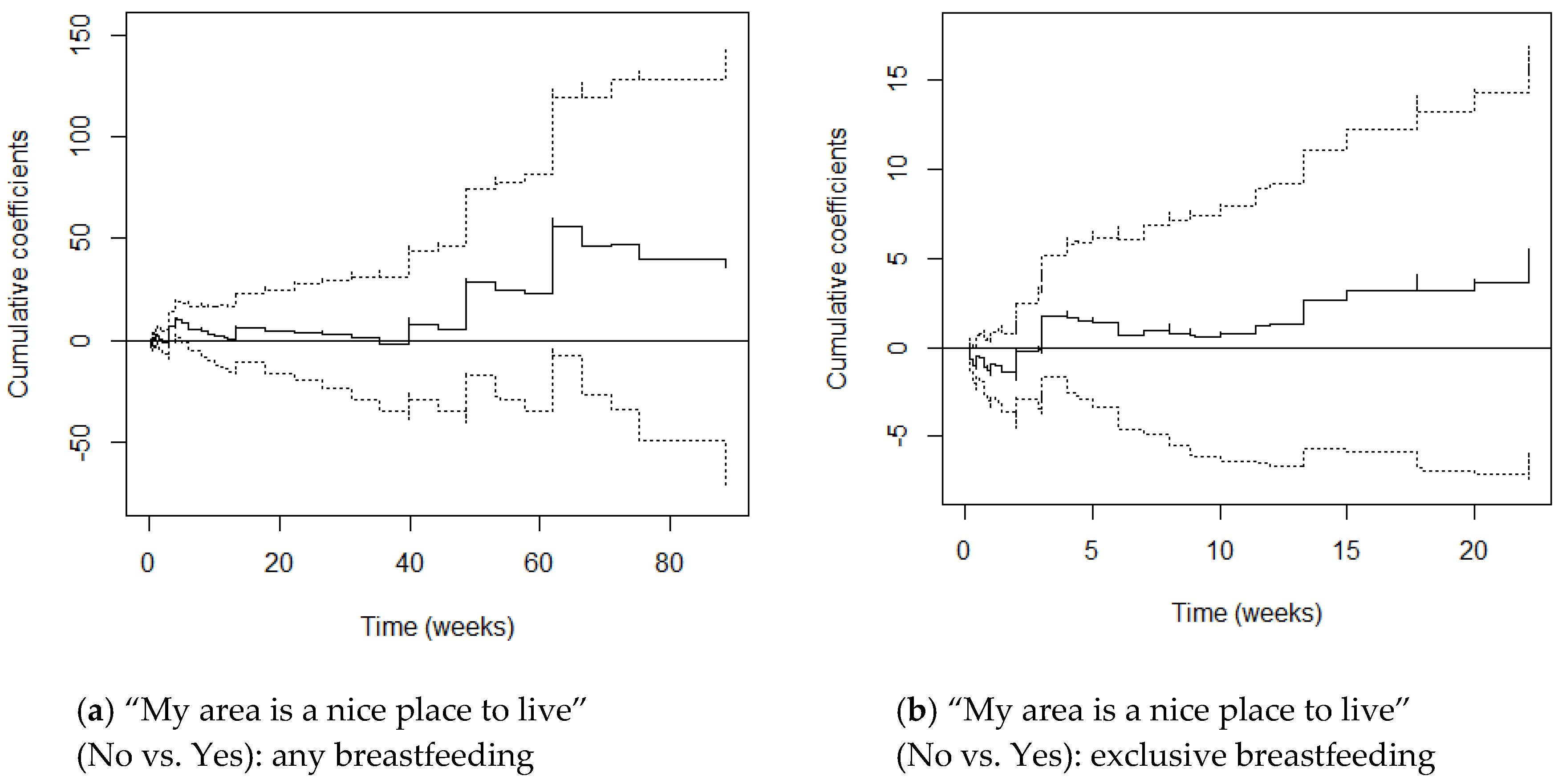
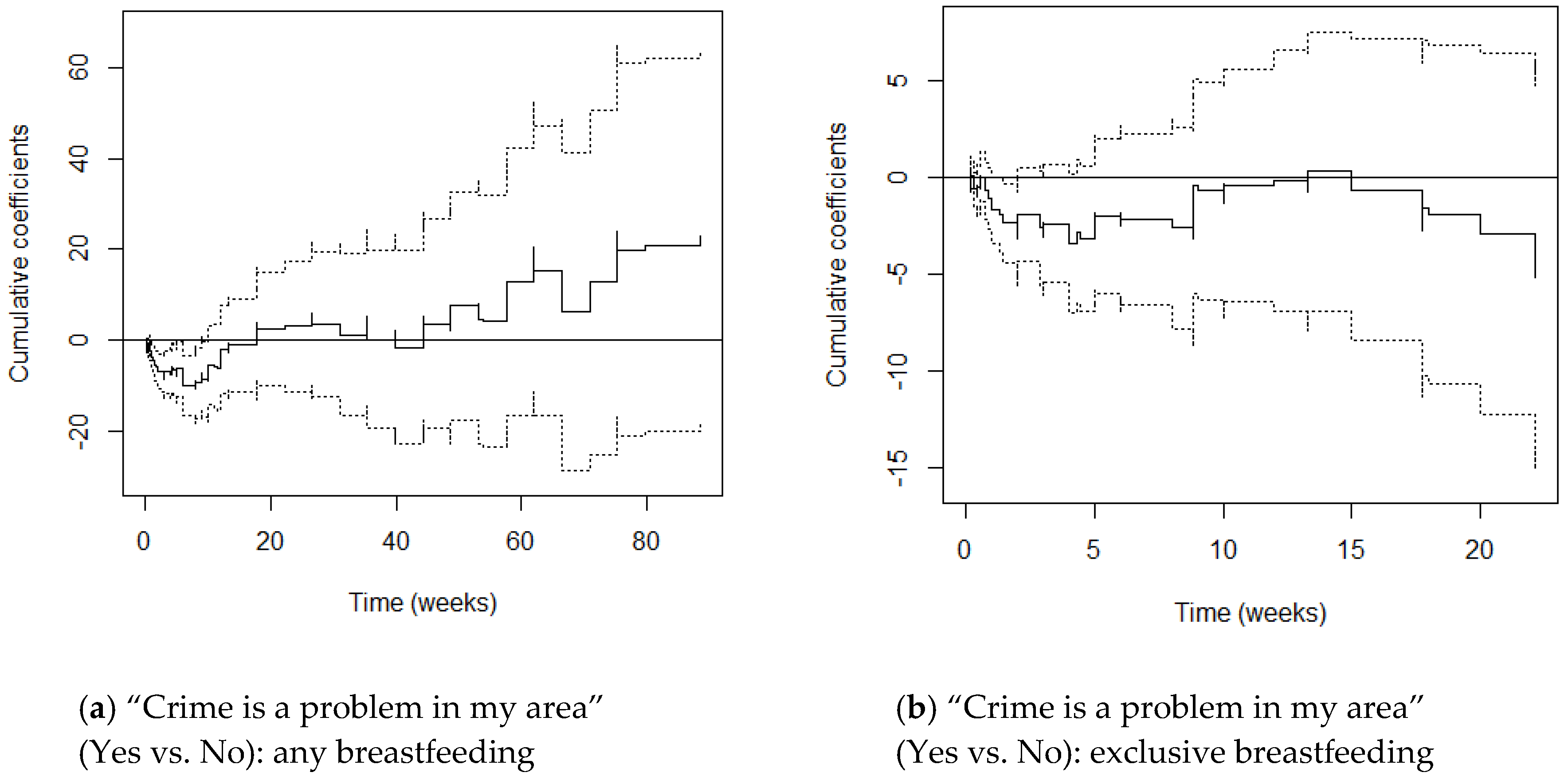
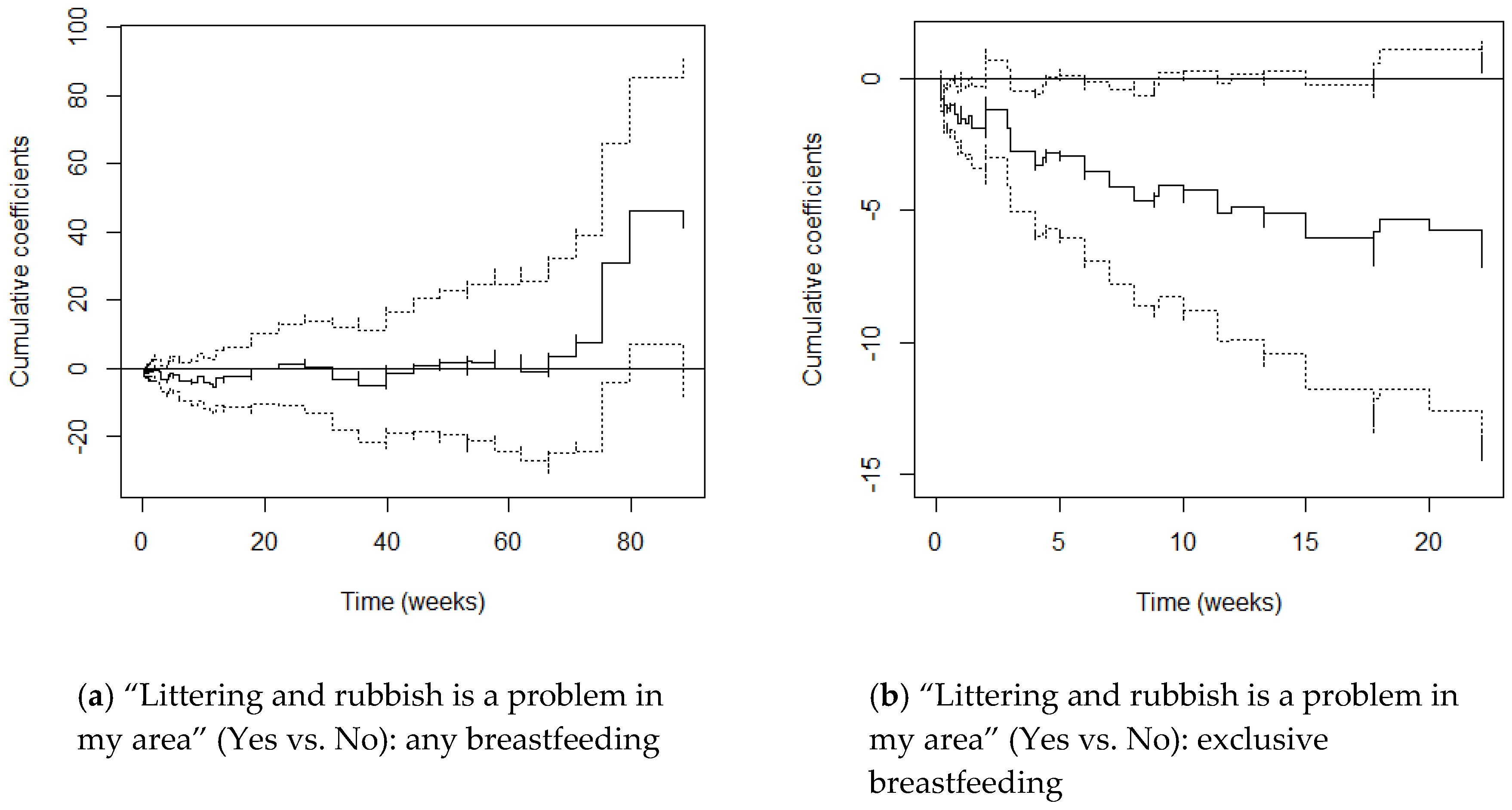
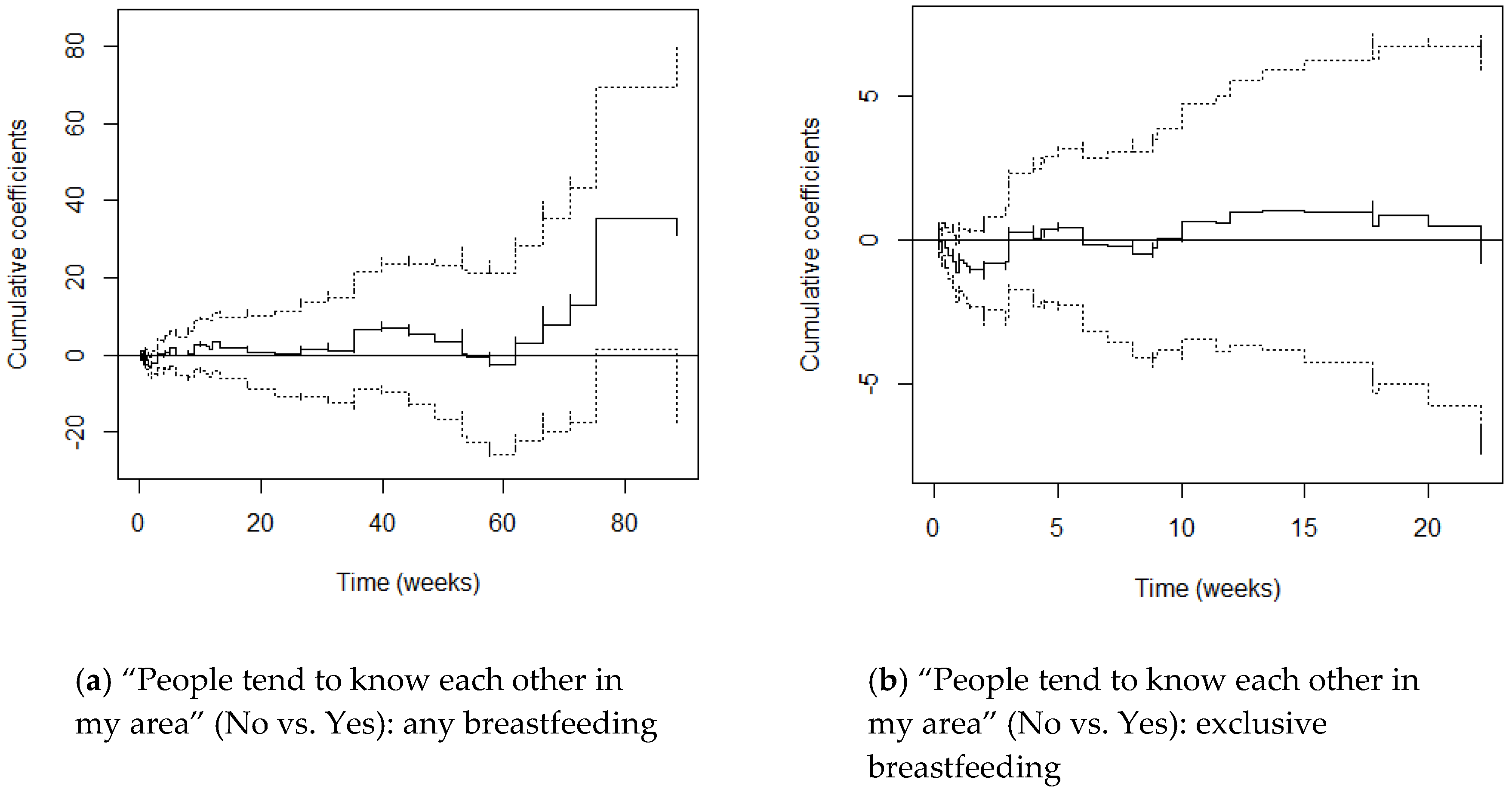
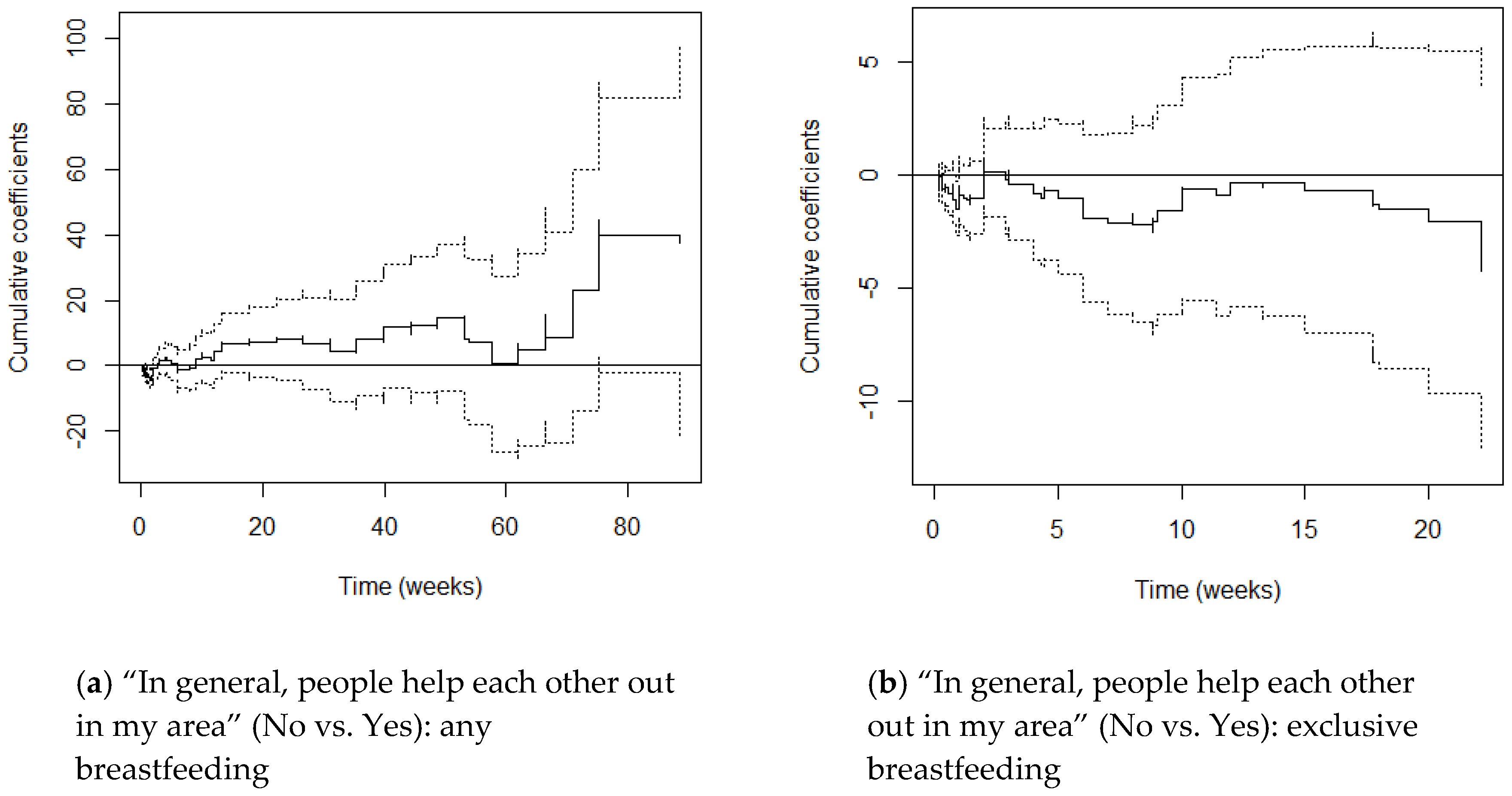
References
- Victora, C.G.; Bahl, R.; Barros, A.J.D.; França, G.V.; Horton, S.; Krasevec, J.; Murch, S.; Sankar, M.J.; Walker, N.; Rollins, N.C. Breastfeeding in the 21st century: Epidemiology, mechanisms, and lifelong effect. Lancet 2016, 387, 475–490. [Google Scholar] [CrossRef]
- McAndrew, F.; Thompson, J.; Fellows, L.; Large, A.; Speed, M.; Renfrew, M.J. Infant Feeding Survey 2010; Health and Social Care Information Centre: Leeds, UK, 2012. [Google Scholar]
- Binns, C.; Lee, M.; Low, W.Y. The long-term public health benefits of breastfeeding. Asia Pac. J. Public Health 2016, 28, 7–14. [Google Scholar] [CrossRef] [PubMed]
- Brown, A. Breastfeeding as a public health responsibility: A review of the evidence. J. Hum. Nutr. Diet 2017, 30, 759–770. [Google Scholar] [CrossRef] [PubMed]
- Tomori, C.; Palmquist, A.E.L.; Quinn, E.A. Introduction: Towards multidisciplinary anthropologies of breastfeeding. In Breastfeeding: New Anthropological Approaches, 1st ed.; Tomori, C., Palmquist, A.E.L., Quinn, E.A., Eds.; Routledge: Oxford, UK; New York, NY, USA, 2017; pp. 1–25. [Google Scholar]
- Emmott, E.H.; Mace, R. Practical support from fathers and grandmothers is associated with lower levels of breastfeeding in the UK Millennium Cohort study. PLoS ONE 2015, 10, e0133547. [Google Scholar] [CrossRef]
- Gartner, L.M.; Morton, J.; Lawrence, R.A.; Naylor, A.J.; O’Hare, D.; Schanler, R.J.; Eidelman, A.I.; American Academy of Pediatrics Section on Breastfeeding. Breastfeeding and the use of human milk. Pediatrics 2005, 115, 496–506. [Google Scholar] [PubMed]
- Condon, L.; Ingram, J. Increasing support for breastfeeding: What can Children’s Centres do? Health Soc. Care Community 2011, 19, 617–625. [Google Scholar] [CrossRef] [PubMed]
- Brown, L.J.; Sear, R. Local environmental quality positively predicts breastfeeding in the UK’s Millennium Cohort Study. Evol. Med. Public Health 2017, 2017, 120–135. [Google Scholar] [CrossRef]
- Brown, L.J.; Sear, R. Are mothers less likely to breastfeed in harsh environments? Physical environmental quality and breastfeeding in the Born in Bradford study. Matern. Child Nutr. 2019, 15, e12851. [Google Scholar] [CrossRef]
- Quinlan, R.J. Extrinsic mortality effects on reproductive strategies in a Caribbean community. Hum. Nat. 2010, 21, 124–139. [Google Scholar] [CrossRef]
- Brown, A.; Raynor, P.; Benton, D.; Lee, M.D. Indices of Multiple Deprivation predict breastfeeding duration in England and Wales. Eur. J. Public Health 2009, 20, 231–235. [Google Scholar] [CrossRef]
- Nettle, D. Dying young and living fast: Variation in life history across English neighborhoods. Behav. Ecol. 2010, 21, 387–395. [Google Scholar] [CrossRef]
- Peregrino, A.B.; Watt, R.G.; Heilmann, A.; Jivraj, S. Breastfeeding practices in the United Kingdom: Is the neighbourhood context important? Matern. Child Nutr. 2018, 14, e12626. [Google Scholar] [CrossRef] [PubMed]
- Roux, A.-V.D. Neighborhoods and health: Where are we and were do we go from here? Rev. d’Épidémiologie St. Publique 2007, 55, 13–21. [Google Scholar] [CrossRef] [PubMed]
- Park, M.; Verhoeven, J.E.; Cuijpers, P.; Iii, C.F.R.; Penninx, B.W.J.H. Where you live may make you old: The Association between perceived poor neighborhood quality and leukocyte telomere length. PLoS ONE 2015, 10, e0128460. [Google Scholar] [CrossRef] [PubMed]
- Pepper, G.V.; Nettle, D. Socioeconomic disparities in health behaviour: An evolutionary perspective. In Applied Evolutionary Anthropology: Darwinian Approaches to Contemporary World Issues; Gibson, M.A., Lawson, D.W., Eds.; Springer: Berlin/Heidelberg, Germany, 2014; pp. 225–243. [Google Scholar]
- Galea, S.; Ahern, J.; Nandi, A.; Tracy, M.; Beard, J.R.; Vlahov, D. Urban neighborhood poverty and the incidence of depression in a population-based cohort study. Ann. Epidemiol. 2007, 17, 171–179. [Google Scholar] [CrossRef] [PubMed]
- Robinette, J.W.; Charles, S.T.; Mogle, J.A.; Almeida, D.M. Neighborhood cohesion and daily well-being: Results from a diary study. Soc. Sci. Med. 2013, 96, 174–182. [Google Scholar] [CrossRef] [PubMed]
- Pearl, M.; Braveman, P.; Abrams, B. The relationship of neighborhood sociodemographic characteristics to birthweight among five ethnic groups in California. Am. J. Public Health 2001, 91, 1808–1824. [Google Scholar] [CrossRef]
- Schempf, A.; Strobino, D.; O’Campo, P. Neighborhood effects on birthweight: An exploration of psychosocial and behavioral pathways in Baltimore, 1995–1996. Soc. Sci. Med. 2009, 68, 100–110. [Google Scholar] [CrossRef]
- Agyemang, C.; Vrijkotte, T.; Droomers, M.; Van Der Wal, M.F.; Bonsel, G.; Stronks, K. The effect of neighbourhood income and deprivation on pregnancy outcomes in Amsterdam, The Netherlands. J. Epidemiol. Community Health 2009, 63, 755–760. [Google Scholar] [CrossRef]
- Morello-Frosch, R.; Shenassa, E.D. The environmental ‘Riskscape’ and social inequality: Implications for explaining maternal and child health disparities. Environ. Health Perspect. 2006, 114, 1150–1153. [Google Scholar] [CrossRef]
- Leventhal, T.; Brooks-Gunn, J. The neighborhoods they live in: The effects of neighborhood residence on child and adolescent outcomes. Psychol. Bull. 2000, 126, 309–337. [Google Scholar] [CrossRef] [PubMed]
- Earls, F.; McGuire, J.; Shay, S. Evaluating a community intervention to reduce the risk of child abuse: Methodological strategies in conducting neighborhood surveys. Child Abus. Negl. 1994, 18, 473–485. [Google Scholar] [CrossRef]
- Department for Communities and Local Government. The English Indices of Deprivation. GOV.UK. 2011. Available online: https://www.gov.uk/government/collections/english-indices-of-deprivation (accessed on 27 September 2020).
- Oakley, L.L.; Kurinczuk, J.J.; Renfrew, M.J.; Quigley, M. Breastfeeding in England: Time trends 2005–2006 to 2012–2013 and inequalities by area profile. Matern. Child Nutr. 2014, 12, 440–451. [Google Scholar] [CrossRef] [PubMed]
- Agboado, G.; Michel, E.; Jackson, E.; Verma, A. Factors associated with breastfeeding cessation in nursing mothers in a peer support programme in Eastern Lancashire. BMC Pediatr. 2010, 10, 3. [Google Scholar] [CrossRef] [PubMed]
- Carter, S.; Williams, M.; Paterson, J.; Iusitini, L. Do perceptions of neighbourhood problems contribute to maternal health?: Findings from the Pacific Islands Families study. Health Place 2009, 15, 622–630. [Google Scholar] [CrossRef]
- Curtis, S.; Southall, H.; Congdon, P.; Dodgeon, B. Area effects on health variation over the life-course: Analysis of the longitudinal study sample in England using new data on area of residence in childhood. Soc. Sci. Med. 2004, 58, 57–74. [Google Scholar] [CrossRef]
- Auger, N.; Daniel, M.; Platt, R.W.; Wu, Y.; Luo, Z.-C.; Choinière, R. Association between perceived security of the neighbourhood and small-for-gestational-age birth. Paediatr. Périnat. Epidemiol. 2008, 22, 467–477. [Google Scholar] [CrossRef]
- Rollings, K.A.; Wells, N.M.; Evans, G.W. Measuring physical neighborhood quality related to health. Behav. Sci. 2015, 5, 190–202. [Google Scholar] [CrossRef]
- O’Campo, P.; Dunn, J.R. Rethinking Social Epidemiology: Towards a Science of Change; Springer Science & Business Media: Berlin, Germany, 2011. [Google Scholar]
- Erickson, A.C. Person, Place and Context: The Interaction between the Social and Physical Environment on Adverse Pregnancy Outcomes in British Columbia; University of Victoria: Victoria, BC, Canada, 2016. [Google Scholar]
- Hystad, P.; Davies, H.W.; Frank, L.; Van Loon, J.; Gehring, U.; Tamburic, L.; Brauer, M. Residential greenness and birth outcomes: Evaluating the influence of spatially correlated built-environment factors. Environ. Health Perspect. 2014, 122, 1095–1102. [Google Scholar] [CrossRef]
- Rydin, Y.; Bleahu, A.; Davies, M.; Dávila, J.D.; Friel, S.; De Grandis, G.; Groce, N.; Hallal, P.C.; Hamilton, I.; Howden-Chapman, P.; et al. Shaping cities for health: Complexity and the planning of urban environments in the 21st century. Lancet 2012, 379, 2079–2108. [Google Scholar] [CrossRef]
- Johns, S.E. Perceived environmental risk as a predictor of teenage motherhood in a British population. Health Place 2011, 17, 122–131. [Google Scholar] [CrossRef]
- Auger, N.; Park, A.L.; Gamache, P.; Pampalon, R.; Daniel, M. Weighing the contributions of material and social area deprivation to preterm birth. Soc. Sci. Med. 2012, 75, 1032–1037. [Google Scholar] [CrossRef] [PubMed]
- Lorenc, T.; Petticrew, M.P.; Whitehead, M.; Neary, D.; Clayton, S.; Wright, K.; Thomson, H.; Cummins, S.; Sowden, A.; Renton, A. Fear of crime and the environment: Systematic review of UK qualitative evidence. BMC Public Health 2013, 13, 496. [Google Scholar] [CrossRef] [PubMed]
- Rosen-Carole, C.; Auinger, P.; Howard, C.R.; Brownell, E.A.; Lanphear, B.P. Low-level prenatal toxin exposures and breastfeeding duration: A prospective cohort study. Matern. Child Health J. 2017, 21, 2245–2255. [Google Scholar] [CrossRef] [PubMed]
- Chisholm, J.S.; Quinlivan, J.A.; Petersen, R.W.; Coall, D.A. Early stress predicts age at menarche and first birth, adult attachment, and expected lifespan. Hum. Nat. 2005, 16, 233–265. [Google Scholar] [CrossRef] [PubMed]
- Geronimus, A.T.; James, S.A.; Destin, M.; Graham, L.F.; Hatzenbuehler, M.L.; Murphy, M.C.; Pearson, J.A.; Omari, A.; Thompson, J.P. Jedi public health: Co-creating an identity-safe culture to promote health equity. SSM Popul. Health 2016, 2, 105–116. [Google Scholar] [CrossRef] [PubMed]
- Emmott, E.H.; Page, A.E.; Myers, S. Typologies of postnatal support and breastfeeding at two months in the UK. Soc. Sci. Med. 2020, 246, 112791. [Google Scholar] [CrossRef]
- Etikan, I.; Musa, S.A.; Alkassim, R.S. Comparison of convenience sampling and purposive sampling. Am. J. Theor. Appl. Stat. 2016, 5, 1. [Google Scholar] [CrossRef]
- Kramer, M.S.; Kakuma, R. The Optimal Duration of Exclusive Breastfeeding: A Systematic Review; World Health Organization: Geneva, Switzerland, 2002. [Google Scholar]
- Furman, L.; Minich, N.M.; Hack, M. Breastfeeding of very low birth weight infants. J. Hum. Lact. 1998, 14, 29–34. [Google Scholar] [CrossRef]
- Sloan, S.; Sneddon, H.; Stewart, M.; Iwaniec, D. Breast is best? Reasons why mothers decide to breastfeed or Bottlefeed their babies and factors influencing the duration of breastfeeding. Child Care Pract. 2006, 12, 283–297. [Google Scholar] [CrossRef]
- Kiernan, K.; Pickett, K.E. Marital status disparities in maternal smoking during pregnancy, breastfeeding and maternal depression. Soc. Sci. Med. 2006, 63, 335–346. [Google Scholar] [CrossRef] [PubMed]
- Kelly, Y.; Watt, R.G.; Nazroo, J. Racial/Ethnic differences in breastfeeding initiation and continuation in the United Kingdom and comparison with findings in the United States. Pediatrics 2006, 118, 1428–1435. [Google Scholar] [CrossRef] [PubMed]
- Awi, D.D.; Alikor, E.A.D. Barriers to timely initiation of breastfeeding among mothers of healthy full-term babies who deliver at the University of Port Harcourt Teaching Hospital. Niger. J. Clin. Pract. 2006, 9, 57–64. [Google Scholar]
- Diemer, M.A.; Mistry, R.S.; Wadsworth, M.E.; López, I.; Reimers, F. Best practices in conceptualizing and measuring social class in psychological research. Anal. Soc. Issues Public Policy 2012, 13, 77–113. [Google Scholar] [CrossRef]
- Dyson, L.; McCormick, F.; Renfrew, M.J. Interventions for promoting the initiation of breastfeeding. Cochrane Database Syst. Rev. 2005, 2, CD001688. [Google Scholar]
- Arlotti, J.P.; Cottrell, B.H.; Lee, S.H.; Curtin, J.J. Breastfeeding among low-income women with and without peer support. J. Community Health Nurs. 1998, 15, 163–178. [Google Scholar] [CrossRef]
- Hackman, N.M.; Schaefer, E.W.; Beiler, J.S.; Rose, C.M.; Paul, I.M. Breastfeeding outcome comparison by parity. Breastfeed. Med. 2015, 10, 156–162. [Google Scholar] [CrossRef]
- Scheike, T.H.; Zhang, M.-J. Analyzing competing risk data using theRtimeregPackage. J. Stat. Softw. 2011, 38, 1–15. [Google Scholar] [CrossRef]
- Hagar, Y.; Dukić, V. Comparison of hazard rate estimation in R. arXiv 2015, arXiv:1509.03253. [Google Scholar]
- Başar, E. Aalen’s additive, cox proportional hazards and the Cox-Aalen Model: Application to kidney transplant data. Sains Malays. 2017, 46, 469–476. [Google Scholar] [CrossRef]
- Amrhein, V.; Greenland, S.; Mcshane, B. Retire statistical significance. Nature 2019, 567, 305–307. [Google Scholar] [CrossRef] [PubMed]
- Smith, R.J. P > 0.05: The incorrect interpretation of “not significant” results is a significant problem. Am. J. Phys. Anthr. 2020, 172, 521–527. [Google Scholar] [CrossRef] [PubMed]
- Resnick, H.S.; Acierno, R.; Kilpatrick, D.G. Health impact of interpersonal violence 2: Medical and mental health outcomes. Behav. Med. 1997, 23, 65–78. [Google Scholar] [CrossRef]
- Lorenc, T.; Clayton, S.; Neary, D.; Whitehead, M.; Petticrew, M.P.; Thomson, H.; Cummins, S.; Sowden, A.; Renton, A. Crime, fear of crime, environment, and mental health and wellbeing: Mapping review of theories and causal pathways. Health Place 2012, 18, 757–765. [Google Scholar] [CrossRef] [PubMed]
- Kaunonen, M.; Hannula, L.; Tarkka, M.-T. A systematic review of peer support interventions for breastfeeding. J. Clin. Nurs. 2012, 21, 1943–1954. [Google Scholar] [CrossRef] [PubMed]
- Brown, A. What do women really want? Lessons for breastfeeding promotion and education. Breastfeed. Med. 2016, 11, 102–110. [Google Scholar] [CrossRef] [PubMed]
- Hector, D.; King, L.; Webb, K.; Heywood, P. Factors affecting breastfeeding practices. Applying a conceptual framework. N. S. W. Public Health Bull. 2005, 16, 52–55. [Google Scholar] [CrossRef]
- Scott, J.; Mostyn, T. Women’s experiences of breastfeeding in a bottle-feeding culture. J. Hum. Lact. 2003, 19, 270–277. [Google Scholar] [CrossRef]
- Sandwell and West Birmingham NHS Trust. More Mums Breastfeeding Babies Despite Coronavirus. MEdia. 2020. Available online: https://www.swbh.nhs.uk/media/more-mums-breastfeeding-babies-despite-coronavirus/ (accessed on 27 September 2020).
- Chan, T.W.; Ermisch, J. Proximity of couples to parents: Influences of gender, labor market, and family. Demography 2015, 52, 379–399. [Google Scholar] [CrossRef]
- Synnott, K.; Bogue, J.; Edwards, C.A.; Scott, J.; Higgins, S.; Norin, E.; Frias, D.; Amarri, S.; Adam, R. Parental perceptions of feeding practices in five European countries: An exploratory study. Eur. J. Clin. Nutr. 2007, 61, 946–956. [Google Scholar] [CrossRef]
- Battersby, S. Not in public please: Breastfeeding as dirty work in the UK. In Exploring the Dirty Side of Women’s Health; Kerkham, M., Ed.; Routledge: London, UK; New York, NY, USA, 2007; pp. 90–101. [Google Scholar]
- Williamson, I.R.; Sacranie, S.M. Nourishing body and spirit: Exploring British Muslim mothers’ constructions and experiences of breastfeeding. Divers. Equal. Health Care 2012, 9, 113–123. [Google Scholar]
- Guxens, M.; Ballester, F.; Espada, M.; Fernández, M.F.; Grimalt, J.; Ibarluzea, J.; Olea, N.; Rebagliato, M.; Tardón, A.; Torrent, M.; et al. Cohort profile: The INMA—INfancia y Medio Ambiente—(environment and childhood) project. Int. J. Epidemiol. 2011, 41, 930–940. [Google Scholar] [CrossRef] [PubMed]
- Naz, S.; Page, A.; Agho, K.E. Household air pollution and under-five mortality in India (1992–2006). Environ. Health 2016, 15, 54. [Google Scholar] [CrossRef]
- Lertxundi, A.; Baccini, M.; Lertxundi, N.; Fano, E.; Aranbarri, A.; Martínez, M.D.; Ayerdi, M.; Álvarez, J.; Santa-Marina, L.; Dorronsoro, M.; et al. Exposure to fine particle matter, nitrogen dioxide and benzene during pregnancy and cognitive and psychomotor developments in children at 15 months of age. Environ. Int. 2015, 80, 33–40. [Google Scholar] [CrossRef]
- Shoji, H.; Koletzko, B. Oxidative stress and antioxidant protection in the perinatal period. Curr. Opin. Clin. Nutr. Metab. Care 2007, 10, 324–328. [Google Scholar] [CrossRef] [PubMed]
- Thomson, G.; Ebisch-Burton, K.; Flacking, R. Shame if you do—Shame if you don’t: Women’s experiences of infant feeding. Matern. Child Nutr. 2014, 11, 33–46. [Google Scholar] [CrossRef] [PubMed]
- Stewart-Knox, B.; Gardiner, K.; Wright, M. What is the problem with breast-feeding? A qualitative analysis of infant feeding perceptions. J. Hum. Nutr. Diet. 2003, 16, 265–273. [Google Scholar] [CrossRef] [PubMed]
- Grant, A. “I…don’t want to see you flashing your bits around”: Exhibitionism, othering and good motherhood in perceptions of public breastfeeding. Geoforum 2016, 71, 52–61. [Google Scholar] [CrossRef]
- Dowling, S.; Brown, A. An exploration of the experiences of mothers who breastfeed long-term: What are the issues and why does it matter? Breastfeed. Med. 2013, 8, 45–52. [Google Scholar] [CrossRef]
- Topolovec-Vranic, J.; Natarajan, K. The use of social media in recruitment for medical research studies: A scoping review. J. Med. Internet Res. 2016, 18, e286. [Google Scholar] [CrossRef]
- Office for National Statistics (ONS). Average Household Income, UK: Financial Year Ending 2019. 2020. Available online: https://www.ons.gov.uk/peoplepopulationandcommunity/personalandhouseholdfinances/incomeandwealth/bulletins/householddisposableincomeandinequality/financialyearending2019 (accessed on 15 September 2020).
- HESA. Higher Education Student Statistics: UK, 2016/17—Qualifications Achieved. 2018. Available online: https://www.hesa.ac.uk/news/11-01-2018/sfr247-higher-education-student-statistics/qualifications (accessed on 15 September 2020).
- Henrich, J.; Heine, S.J.; Norenzayan, A. The weirdest people in the world? SSRN Electron. J. 2010, 33, 61–135. [Google Scholar] [CrossRef]
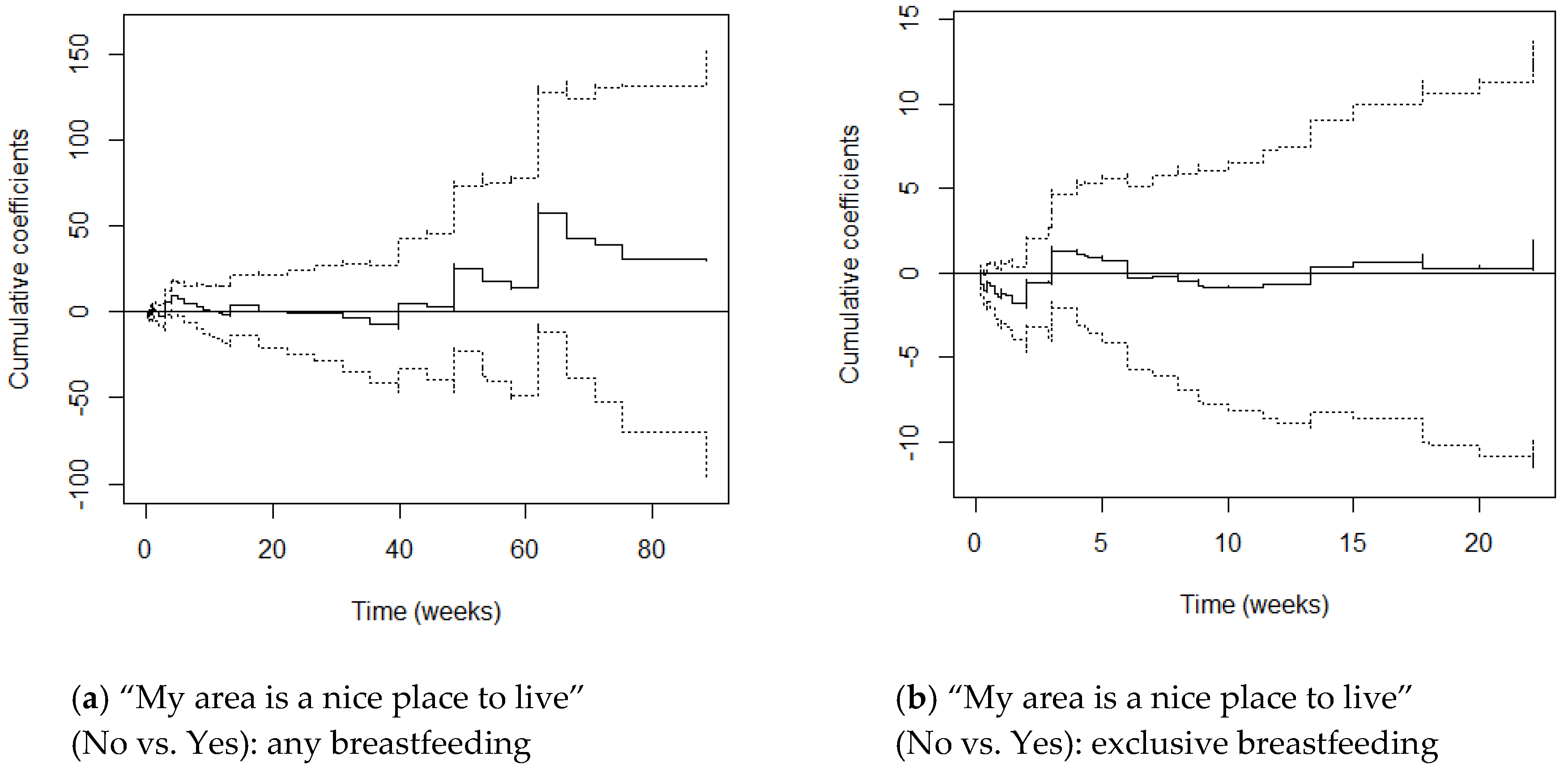
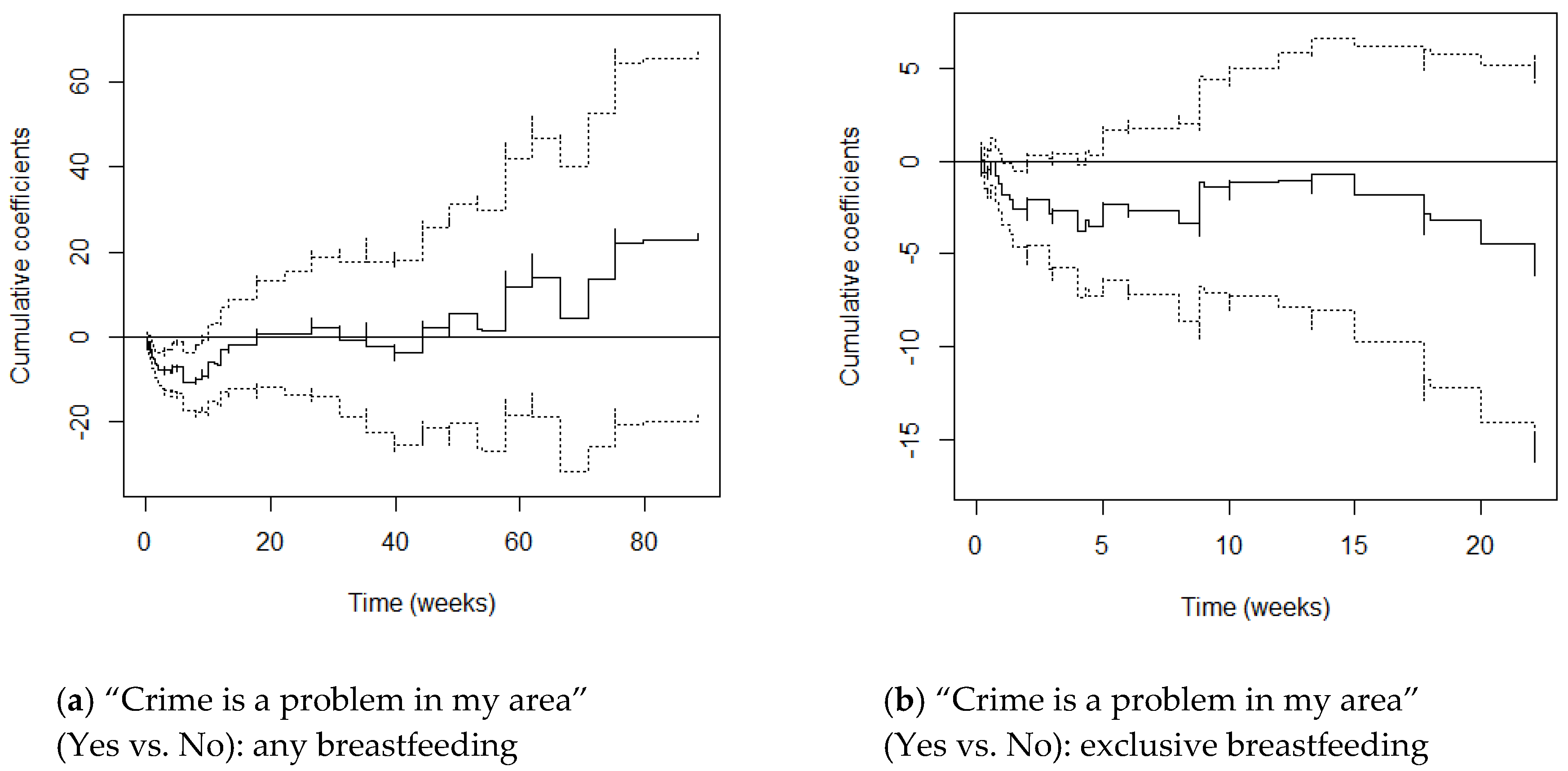
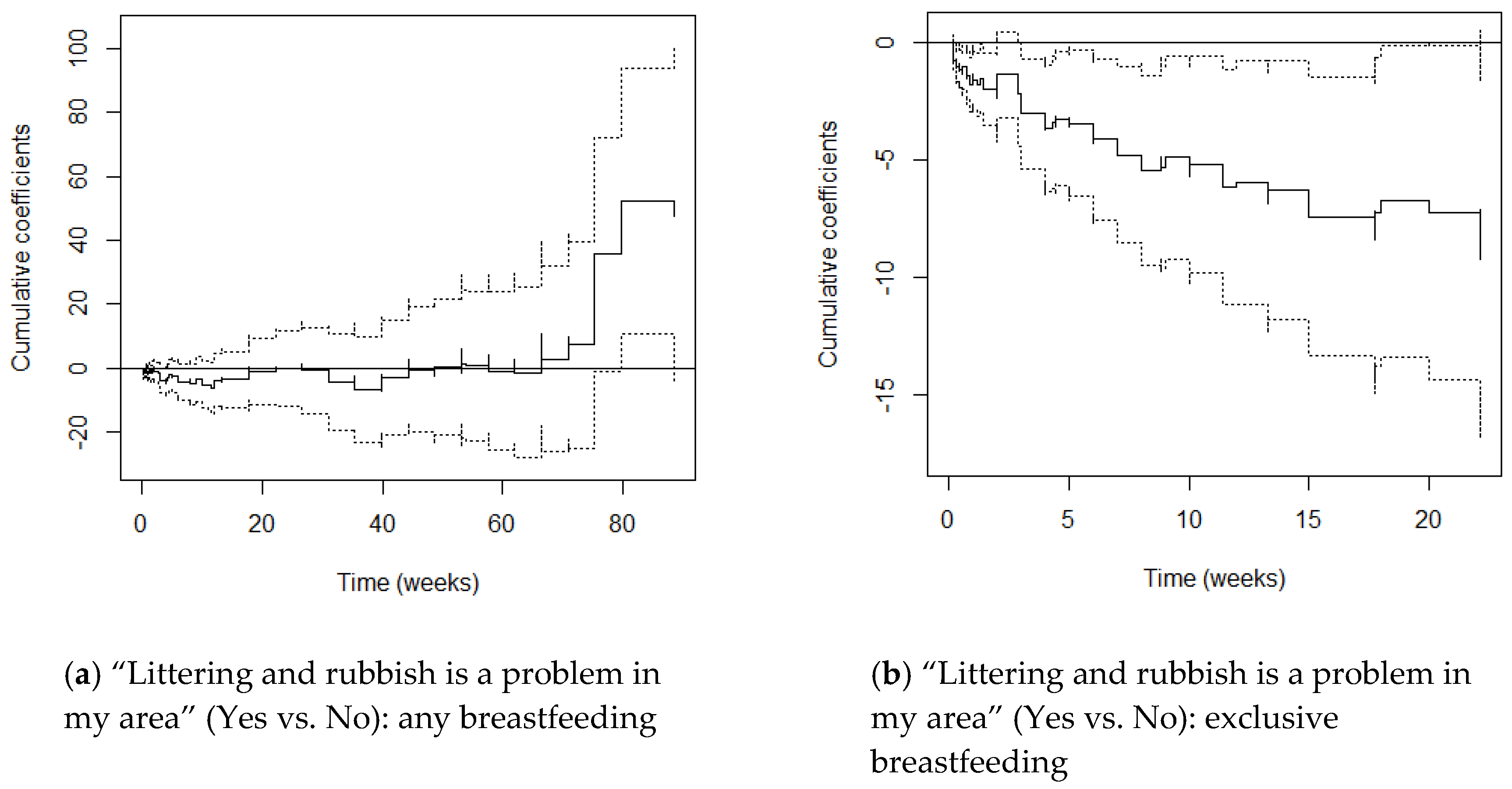
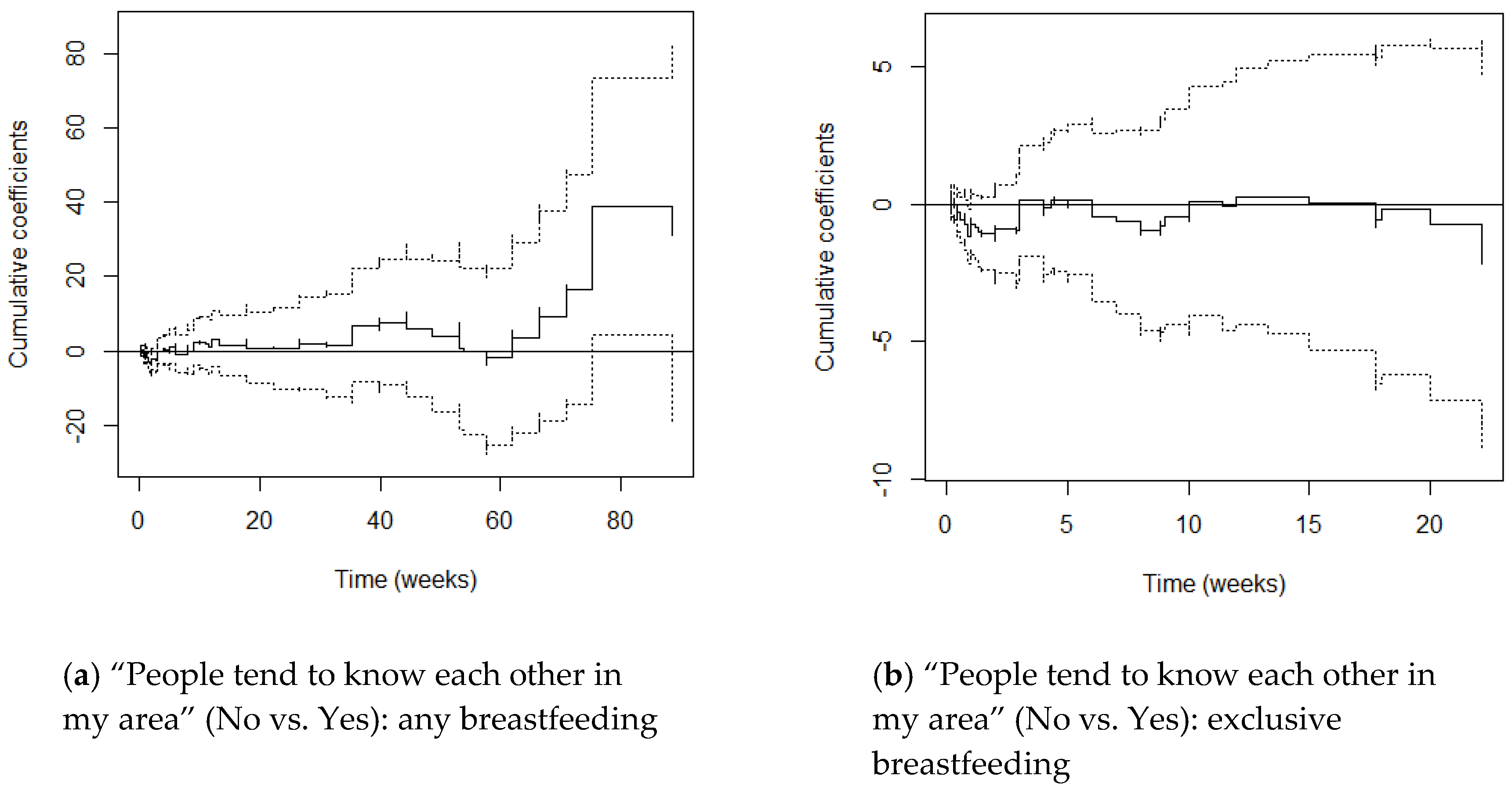
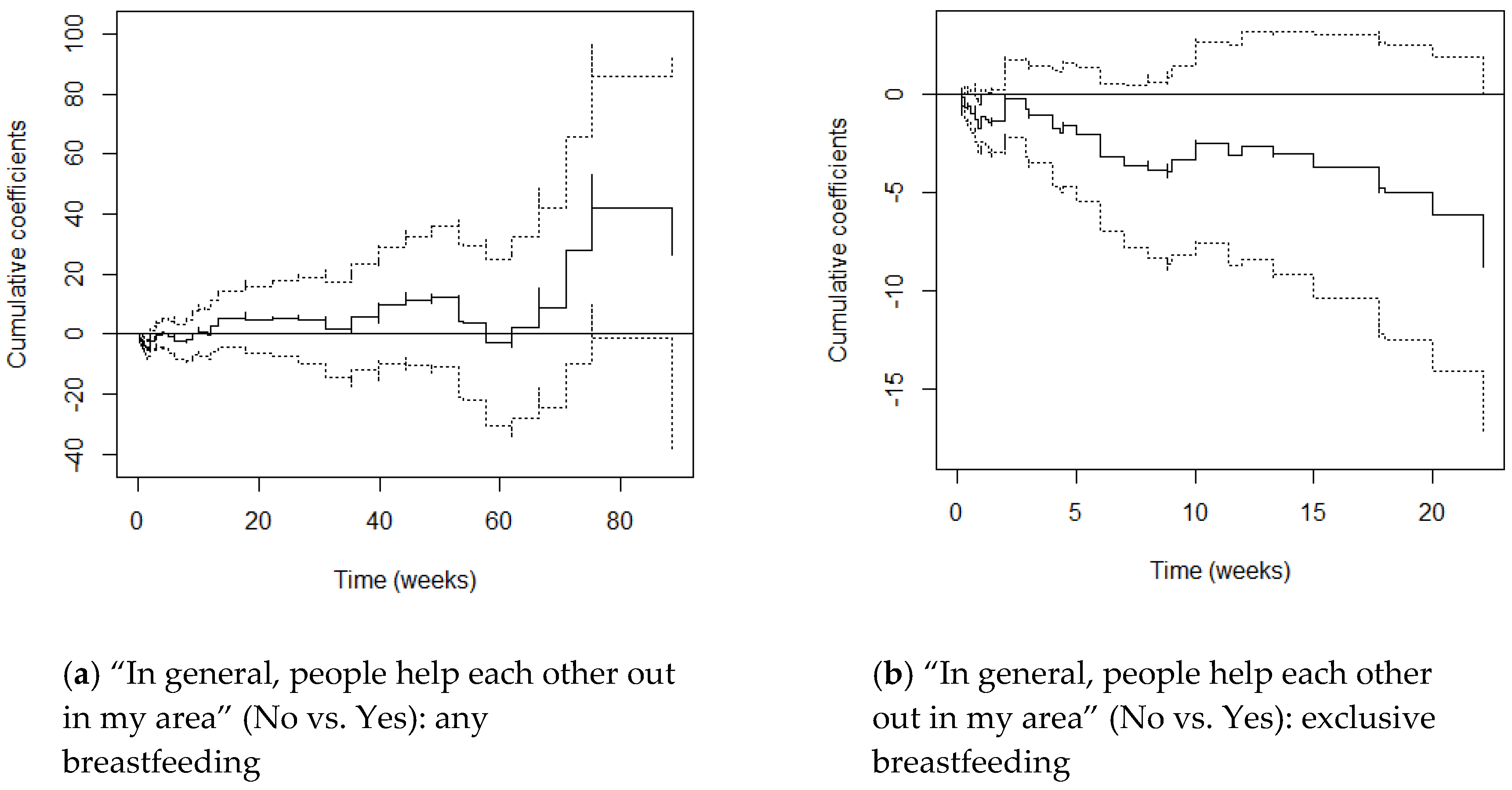
| Characteristics | Breastfeeding Initiation (n = 512) | Duration of Any Breastfeeding (weeks) (n = 480) | Duration of Exclusive Breastfeeding (weeks) (n = 293) | ||||||
|---|---|---|---|---|---|---|---|---|---|
| n | n (%) | p-Value 1 | n | Median (IQR) | p-Value 3 | n | Median (IQR) | p-Value 3 | |
| Subjective environmental experiences | |||||||||
| My area is a nice place to live | |||||||||
| Yes | 482 | 453 (94.0%) | 453 | 31.7 (41.7) | 277 | 22.1 (23.7) | |||
| No | 22 | 20 (90.9%) | 0.638 | 20 | 19.0 (34.3) | 0.113 | 13 | 13.3 (24.6) | 0.630 |
| Missing | 8 | 7 (87.5%) | 7 | 53.4 (49.6) | 3 | 26.6 (0.0) | |||
| Crime is a problem in my area | |||||||||
| No | 378 | 355 (93.9%) | 355 | 31.0 (42.4) | 213 | 22.1 (24.6) | |||
| Yes | 59 | 54 (91.5%) | 0.564 | 54 | 33.8 (44.2) | 0.331 | 37 | 22.1 (20.6) | 0.537 |
| Missing | 75 | 71 (94.7%) | 71 | 31.7 (44.3) | 43 | 17.7 (23.6) | |||
| Littering and rubbish is a problem in my area | |||||||||
| No | 387 | 364 (94.1%) | 364 | 31.4 (43.0) | 220 | 22.1 (24.6) | |||
| Yes | 104 | 97 (93.3%) | 0.947 2 | 97 | 29.4 (50.0) | 0.486 | 63 | 22.1 (19.6) | 0.179 |
| Missing | 21 | 19 (90.5%) | 19 | 34.0 (20.2) | 10 | 24.4 (8.3) | |||
| People tend to know each other in my area | |||||||||
| Yes | 329 | 308 (93.6%) | 308 | 34.3 (43.1) | 186 | 22.1 (24.4) | |||
| No | 121 | 116 (95.9%) | 0.470 2 | 116 | 27.6 (42.0) | 0.313 | 74 | 20.1 (23.6) | 0.882 |
| Missing | 62 | 56 (90.3%) | 56 | 32.4 (40.6) | 33 | 26.6 (21.6) | |||
| In general, people help each other out in my area | |||||||||
| Yes | 361 | 339 (93.9%) | 339 | 33.0 (41.4) | 205 | 22.1 (23.7) | |||
| No | 77 | 71 (92.2%) | 0.607 | 71 | 28.0 (40.9) | 0.419 | 46 | 26.6 (24.3) | 0.596 |
| Missing | 74 | 70 (94.6%) | 70 | 27.2 (52.4) | 42 | 17.7 (23.3) | |||
| Area | |||||||||
| England | |||||||||
| East Midlands | 21 | 16 (76.2%) | 16 | 27.4 (39.1) | 12 | 26.6 (17.8) | |||
| East of England | 34 | 31 (91.2%) | 31 | 31.0 (27.6) | 18 | 26.6 (19.6) | |||
| South East | 89 | 83 (93.3%) | 83 | 29.4 (51.1) | 51 | 17.7 (25.6) | |||
| Yorkshire & The Humber | 57 | 54 (94.7%) | 54 | 35.5 (40.7) | 36 | 26.6 (20.6) | |||
| North East | 45 | 43 (95.6%) | 43 | 26.3 (29.2) | 20 | 13.3 (25.2) | |||
| West Midlands | 23 | 22 (95.7%) | 22 | 16.5 (40.6) | 11 | 3.0 (16.0) | |||
| London | 69 | 66 (95.7%) | 66 | 35.4 (37.0) | 46 | 24.4 (19.1) | |||
| North West | 61 | 59 (96.7%) | 59 | 35.4 (46.6) | 38 | 21.1 (22.3) | |||
| South West | 54 | 53 (98.1%) | 53 | 29.9 (42.7) | 26 | 19.9 (23.3) | |||
| Wales | 21 | 18 (85.7%) | 18 | 33.2 (26.8) | 12 | 16.3 (22.8) | |||
| Scotland | 32 | 29 (90.6%) | 29 | 30.3 (32.1) | 20 | 22.1 (23.8) | |||
| Northern Ireland | 6 | 6 (100.0%) | 0.607 | 6 | 33.2 (44.3) | 0.926 | 3 | 0.9 (13.1) | 0.439 |
| Maternal and infant characteristics | |||||||||
| Maternal age (years) | |||||||||
| 16–24 | 24 | 20 (83.3%) | 20 | 24.4 (38.7) | 9 | 6.0 (25.1) | |||
| 25–29 | 98 | 87 (88.8%) | 87 | 22.1 (44.1) | 55 | 12.0 (25.1) | |||
| 30–34 | 245 | 232 (94.7%) | 232 | 34.5 (46.5) | 140 | 22.1 (23.9) | |||
| 35–39 | 121 | 119 (98.3%) | 119 | 35.4 (34.6) | 76 | 26.6 (16.9) | |||
| 40–44 | 24 | 22 (91.7%) | 0.005 | 22 | 27.4 (44.5) | 0.194 | 13 | 26.6 (25.6) | 0.150 |
| Parity | |||||||||
| 1st birth | 313 | 292 (93.3%) | 292 | 31.0 (41.7) | 177 | 18.0 (24.6) | |||
| 2nd or higher | 199 | 188 (94.5%) | 0.726 2 | 188 | 32.6 (44.5) | 0.921 | 116 | 26.6 (22.1) | 0.083 |
| Ethnicity | |||||||||
| White | 490 | 459 (93.7%) | 459 | 31.7 (43.1) | 282 | 22.1 (23.6) | |||
| Other | 22 | 21 (95.5%) | 1.000 | 21 | 29.4 (44.1) | 0.710 | 11 | 17.1 (25.4) | 0.724 |
| Partnership status | |||||||||
| Partnered | 501 | 469 (93.6%) | 469 | 31.1 (43.1) | 288 | 22.1 (23.6) | |||
| Unpartnered | 11 | 11 (100.0%) | 1.000 | 11 | 52.6 (41.9) | 0.295 | 5 | 26.6 (25.6) | 0.993 |
| Birthweight | |||||||||
| Normal (≥2500 g) | 483 | 452 (93.6%) | 452 | 31.9 (43.2) | 282 | 22.1 (23.6) | |||
| Low (<2500 g) | 20 | 20 (100.0%) | 0.626 | 20 | 28.1 (33.7) | 0.609 | 8 | 13.4 (25.5) | 0.561 |
| Missing | 9 | 8 (88.9%) | 8 | 13.4 (21.7) | 3 | 8.9 (8.4) | |||
| Socioeconomic Status | |||||||||
| Education | |||||||||
| GCSEs or AS/A-levels | 94 | 84 (89.4%) | 84 | 19.5 (36.5) | 56 | 8.0 (25.1) | |||
| Graduate | 198 | 179 (90.4%) | 179 | 27.9 (35.9) | 107 | 26.6 (23.6) | |||
| Postgraduate | 220 | 217 (98.6%) | <0.001 2 | 217 | 38.7 (41.0) | <0.001 4 | 130 | 26.3 (22.6) | 0.003 4 |
| Annual income | |||||||||
| Under £50,000 | 206 | 189 (91.7%) | 189 | 31.7 (44.3) | 113 | 26.6 (23.7) | |||
| £50,000 plus | 278 | 264 (95.0%) | 0.215 2 | 264 | 31.0 (39.9) | 0.782 | 159 | 22.1 (23.6) | 0.472 |
| Missing | 28 | 27 (96.4%) | 27 | 38.9 (42.1) | 21 | 17.7 (18.6) | |||
| Financial Situation | |||||||||
| Finding it difficult | 34 | 30 (88.2%) | 30 | 22.1 (42.5) | 14 | 7.4 (24.6) | |||
| Just about getting by | 100 | 96 (96.0%) | 96 | 31.9 (43.8) | 58 | 26.6 (21.3) | |||
| Doing alright | 230 | 216 (93.9%) | 216 | 31.0 (42.4) | 136 | 22.1 (24.6) | |||
| Living comfortably | 144 | 134 (93.1%) | 0.408 | 134 | 35.4 (41.6) | 0.643 | 81 | 22.1 (22.6) | 0.559 |
| Missing | 4 | 4 (100.0%) | 4 | 17.7 (11.2) | 4 | 17.7 (5.6) | |||
| Partner’s employment status | |||||||||
| Unemployed | 12 | 10 (83.3%) | 10 | 36.6 (77.6) | 8 | 26.6 (20.2) | |||
| Employed | 489 | 459 (93.9%) | 0.175 | 459 | 31.1 (42.9) | 0.440 | 280 | 22.1 (23.6) | 0.503 |
| Missing | 11 | 11 (100.0%) | 11 | 52.6 (41.9) | 5 | 26.6 (25.6) | |||
| M1: Controlling for Age and Parity | M2: Additionally Controlling for Education | ||||||||||
|---|---|---|---|---|---|---|---|---|---|---|---|
| Constant Effect | Time-Varying Effect | Constant Effect | Time-Varying Effect | ||||||||
| n | HR (95% CI) | p-Value | Sup. p-Value | K-S p-Value | CvM p-Value | HR (95% CI) | p-Value | Sup. p-Value | K-S p-Value | CvM p-Value | |
| Nice (No vs. Yes) | 473 | 1.44 (0.73–2.86) | 0.351 | 0.069 | 0.480 | 0.617 | 1.26 (0.62–2.53) | 0.569 | 0.066 | 0.455 | 0.607 |
| Crime (Yes vs. No) | 409 | 1.15 (0.75–1.77) | 0.551 | 0.006 | 0.755 | 0.676 | 1.12 (0.72–1.74) | 0.642 | 0.002 | 0.590 | 0.470 |
| Litter (Yes vs. No) | 461 | 1.08 (0.76–1.53) | 0.693 | 0.139 | 0.179 | 0.156 | 1.05 (0.74–1.51) | 0.789 | 0.114 | 0.256 | 0.132 |
| Know (No vs. Yes) | 424 | 1.16 (0.82–1.63) | 0.441 | 0.694 | 0.331 | 0.364 | 1.18 (0.84–1.67) | 0.391 | 0.631 | 0.328 | 0.432 |
| Help (No vs. Yes) | 410 | 1.31 (0.89–1.95) | 0.239 | 0.593 | 0.387 | 0.54 | 1.23 (0.82–1.82) | 0.408 | 0.385 | 0.520 | 0.682 |
| M1: Controlling for Age and Parity | M2: Additionally Controlling for Education | ||||||||||
|---|---|---|---|---|---|---|---|---|---|---|---|
| Constant Effect | Time-Varying Effect | Constant Effect | Time-Varying Effect | ||||||||
| n | HR (95% CI) | p-Value | Sup. p-Value | K-S p-Value | CvM p-Value | HR (95% CI) | p-Value | Sup. p-Value | K-S p-Value | CvM p-Value | |
| Nice (No vs. Yes) | 290 | 1.03 (0.49–2.19) | 0.928 | 0.017 | 0.587 | 0.851 | 0.86 (0.40–1.85) | 0.692 | 0.032 | 0.682 | 0.865 |
| Crime (Yes vs. No) | 250 | 0.91 (0.55–1.49) | 0.662 | 0.139 | 0.458 | 0.369 | 0.83 (0.50–1.40) | 0.431 | 0.131 | 0.463 | 0.383 |
| Litter (Yes vs. No) | 283 | 0.78 (0.52–1.17) | 0.158 | <0.001 | 0.434 | 0.227 | 0.72 (0.47–1.09) | 0.061 | 0.002 | 0.374 | 0.163 |
| Know (No vs. Yes) | 260 | 0.90 (0.62–1.32) | 0.584 | 0.818 | 0.351 | 0.247 | 0.87 (0.59–1.27) | 0.458 | 0.692 | 0.637 | 0.271 |
| Help (No vs. Yes) | 251 | 0.77 (0.48–1.23) | 0.266 | 0.159 | 0.236 | 0.127 | 0.65 (0.40–1.05) | 0.081 | 0.202 | 0.207 | 0.146 |
Publisher’s Note: MDPI stays neutral with regard to jurisdictional claims in published maps and institutional affiliations. |
© 2020 by the authors. Licensee MDPI, Basel, Switzerland. This article is an open access article distributed under the terms and conditions of the Creative Commons Attribution (CC BY) license (http://creativecommons.org/licenses/by/4.0/).
Share and Cite
Brown, L.J.; Myers, S.; Page, A.E.; Emmott, E.H. Subjective Environmental Experiences and Women’s Breastfeeding Journeys: A Survival Analysis Using an Online Survey of UK Mothers. Int. J. Environ. Res. Public Health 2020, 17, 7903. https://doi.org/10.3390/ijerph17217903
Brown LJ, Myers S, Page AE, Emmott EH. Subjective Environmental Experiences and Women’s Breastfeeding Journeys: A Survival Analysis Using an Online Survey of UK Mothers. International Journal of Environmental Research and Public Health. 2020; 17(21):7903. https://doi.org/10.3390/ijerph17217903
Chicago/Turabian StyleBrown, Laura J., Sarah Myers, Abigail E. Page, and Emily H. Emmott. 2020. "Subjective Environmental Experiences and Women’s Breastfeeding Journeys: A Survival Analysis Using an Online Survey of UK Mothers" International Journal of Environmental Research and Public Health 17, no. 21: 7903. https://doi.org/10.3390/ijerph17217903
APA StyleBrown, L. J., Myers, S., Page, A. E., & Emmott, E. H. (2020). Subjective Environmental Experiences and Women’s Breastfeeding Journeys: A Survival Analysis Using an Online Survey of UK Mothers. International Journal of Environmental Research and Public Health, 17(21), 7903. https://doi.org/10.3390/ijerph17217903






